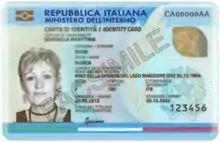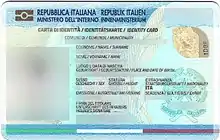Italian electronic identity card
The carta di identità elettronica (Electronic Identity Card, CIE) is an Italian personal identification document issued to any Italian citizen and to legal aliens, that has been progressively replacing the paper-based identity card since the latest version (CIE 3.0) has been released on 4 July 2016.
| Italian electronic identity card (Carta di identità elettronica) | |
|---|---|
.png.webp) CIE 3.0 | |
| Type | Optional identity document |
| Issued by | |
| First issued | 4 July 2016 |
| Purpose | Identification & travel |
| Valid in | |
| Eligibility | Italian citizenship, or else any citizenship if legally residing in Italy |
| Expiration |
|
| Cost |
|
The CIE is intended for both online and offline identification.
The information is either printed on an ID-1 card or stored in a contactless chip.[1]
After about 15 years of trials, finally as per decree of 25 May 2016 every classic identity card with expired validity must be replaced by the electronic version.[2]
On 18 July 2019, the Minister of Foreign Affairs signed a decree allowing Italians who reside abroad to request an electronic identity card.[3][4]
Overview
The Italian identity card is an optional identity document that may be issued to anyone resident in Italy and to Italian citizens living abroad.
A card issued to an Italian citizen is accepted in lieu of a passport to exercise the right of free movement in the European Economic Area and Switzerland or to travel to those countries with which Italy has signed specific agreements.[5][6]
Despite any government-issued document (such as the passport, the driving licence, etc...) can be shown for identification,[7] the identity card is very widespread in Italy; so much so that it is the first document asked and the most accepted in both the public and private sectors.
It is not compulsory to carry the card itself, as the authorities may ask for only the identity of a person, not a specific document. However, if public-security officers are not convinced of the claimed identity, such as a verbal claim of identity, they may hold the claimant in custody until the identity is ascertained.[8][9]
All foreigners in Italy are required by law to have identification with them at all times. Citizens of the European Economic Area and Switzerland must be ready to display an identity document that is legally government-issued in their country. Non-EEA citizens must have their passport with customs entrance stamp or a residence permit issued by Italian authorities. While all the resident/immigrant aliens must have a residence permit (otherwise they are illegal and face deportation), foreigners from certain non-EEA countries staying in Italy for a limited amount of time (typically for tourism) may be required only to have their passport with proper customs stamp.[10]
Permanent resident aliens with a valid permesso di soggiorno (residence permit) may request an identity card, but in this case it is valid only and exclusively in Italy for identification purposes.[11]
Issuing system & costs
The CIE may be requested at the Italian municipality of residence[12] by Italian citizens and resident aliens. The request is digitally processed and transmitted to the Ministry of Internal Affairs which issues the card in collaboration with the IPZS in Rome. Finally, the card is sent to an address chosen by the applicant (or else to the municipality) and it should arrive within 6 business days.[13] The costs are: €16.79 for the card issuing and €5.42 for fees charged by the municipality, which may vary (usually doubled) if the previous card was lost, stolen or deteriorated.[12]
Starting from 20 September 2019 the request may be submitted even at the Italian embassies/consulates just by Italian citizens residing abroad. After a test time at the consular offices in Vienna, Athens and Nice, the service is extended to all the European Union and to some countries where Italians have the right of free movement (Norway, Monaco, San Marino, Switzerland and Vatican City).[14] The issuing process is the same as in Italy and the card should arrive within 15 days.[14] The costs are: €21.95 in case of renewal or first issue, otherwise €27.11 if the previous card was lost or stolen.[14]
Validity
According to the Law 106/2011 the card lasts:[12]
- 10 years for adults aged 18 and above
- 5 years for minors aged 3–18
- 3 years for children aged up to 3
and, according to the Law 35/2012, the validity is extended or shortened in order to expire on the birthday.[15]
Contactless chip

Like European biometric passports, the CIE has an embedded electronic microprocessor chip that stores the following items:[16]
- Name
- Surname
- Place and date of birth
- Residency
- Holder's picture
- Two fingerprints (one of each hand), only if the applicant is aged 12 or over[17]
The information can be read by means of NFC tools, but anyway fingerprints are accessible just by police forces.[16]
Physical appearance
The card has an ID-1 standard size and it is made of polycarbonate with many security features (such as holograms, security backgrounds, micro-texts, guilloches, etc...), over which the information is printed by using the laser engraving technology.[1][18]
The front side bears the emblem of the Italian Republic and the background of the reverse side is derived from the geometric design of the Piazza del Campidoglio in Rome created by Renaissance artist and architect Michelangelo Buonarroti.[18]
The descriptions of the fields are printed in Italian and English.
Front

- Card number (for example CA00000AA)
- Issuing municipality (or, if living abroad, issuing embassy/consulate)
- Surname
- Name
- Place and date of birth
- Sex
- Height
- Nationality
- Date of issue
- Date of expiry
- Holder's signature
- Card Access Number – CAN
- This field is located under the CAN and it doesn't exist if the document is valid to travel abroad. On the contrary, the sentence "NON VALIDA PER L'ESPATRIO" is printed if it's not valid to travel abroad.
Reverse
.png.webp)
- Surname and name of parents or legal guardian (this field is filled in only for applicants aged 0–18)
- Italian fiscal code
- Italian birth code
- Residence address
- This field is located under the residence and it usually doesn't exist. However, in case of an Italian applicant living abroad, the sentence "COMUNE DI ISCRIZIONE AIRE" is printed and followed by the name of the municipality where the applicant was resident before moving abroad
- Italian fiscal code in the form of barcode
- Machine Readable Zone – MRZ
Trilingual versions


In some parts of Italy where a minority language is recognized as official, the identity card could be issued with an additional language:
- in South Tyrol with German
- in the Aosta Valley with French
- in Friuli Venezia Giulia with Slovene
See also
References
- "Caratteristiche del documento". Carta di identità elettronica (in Italian). Retrieved 24 June 2019.
- Gazzetta Ufficiale. "DECRETO 25 maggio 2016". Retrieved 2 February 2018.
- "Carta d'identità elettronica per gli italiani all'estero". www.esteri.it. Retrieved 27 August 2019.
- ""Carta d'identità elettronica": firmato il Decreto contenente le modalità di emissione per i cittadini italiani residenti all'Estero". Enti Locali Online (in Italian). 5 August 2019. Retrieved 7 August 2019.
- "I servizi demografici". Dipartimento per gli affari interni e territoriali (in Italian). 25 November 2016. Retrieved 24 June 2019.
- "I documenti per viaggiare". www.poliziadistato.it. Retrieved 24 June 2019.
- "D.P.R. 445/2000". www.parlamento.it. Retrieved 30 January 2020.
- "Download di: Regio Decreto 18 giugno 1931, n. 773 T.U.L.P.S. (testo unico delle leggi di pubblica sicurezza)". Il portale delle Prefetture-UTG (in Italian). Retrieved 24 June 2019.
- "Che si rischia a camminare senza documenti d'identità?". La Legge per Tutti (in Italian). Retrieved 24 June 2019.
- "Identificazione di persone - Sicurezza Pubblica". sicurezzapubblica.wikidot.com. Retrieved 24 June 2019.
- "Gazzetta Ufficiale". www.gazzettaufficiale.it. Retrieved 24 June 2019.
- "La richiesta al Comune". Carta di identità elettronica (in Italian). Retrieved 24 June 2019.
- "Modalità di spedizione del documento". Carta di identità elettronica (in Italian). Retrieved 24 June 2019.
- "Carta d'identità". www.esteri.it (in Italian). Retrieved 29 January 2020.
- "Circolare n. 7/2012 – Scadenza dei documenti di identità e di riconoscimento". Ministro per la Pubblica Amministrazione (in Italian). 20 July 2012. Retrieved 23 July 2019.
- "Il microchip". Carta di identità elettronica (in Italian). Retrieved 25 June 2019.
- "Modalità di acquisizione impronte". Carta di identità elettronica (in Italian). Retrieved 25 June 2019.
- "Elementi di sicurezza". Carta di identità elettronica (in Italian). Retrieved 30 January 2020.